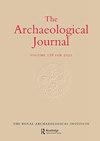“What are the dead for?” Bronze Age burials in a multi-period landscape at Bucklow Hill, Cheshire
IF 0.9
0 ARCHAEOLOGY
引用次数: 0
Abstract
ABSTRACT Excavations in 2014–15 in the vicinity of Bucklow Hill revealed two clusters of cremated human remains, one focused on a ring-ditch, the other on a similar but destroyed monument. Ephemeral traces of earlier activity were found. A programme of radiocarbon dating revealed the earliest human remains in both clusters to be Early Bronze Age, with burial continuing episodically until the Middle Bronze Age. Environmental remains indicate the exploitation of wild plants and cultivation of hardy hulled wheats and barley in the Bronze Age. A group of probable early medieval inhumation graves were dug into the ring-ditch. As well as these graves, scattered medieval pits were also found; oats, barley and rye were grown during this period. These later remains are of significance as there is a dearth of comparable evidence from rural sites in the region and this contributes to the emerging understanding of the reuse of prehistoric funerary monuments in the English north midlands.“死人有什么用?”柴郡巴克罗山多时期景观中的青铜时代墓葬
2014 - 2015年在巴克罗山附近的挖掘中发现了两组火化的人类遗骸,一组集中在环形沟渠上,另一组集中在类似但已被摧毁的纪念碑上。发现了早期活动的短暂痕迹。一项放射性碳定年计划显示,这两个群体中最早的人类遗骸都是青铜时代早期的,埋葬的时间断断续续地持续到青铜时代中期。环境遗迹表明,在青铜器时代,人们对野生植物进行了开发,并种植了耐寒的小麦和大麦。在环形沟里挖出了一组可能是中世纪早期的人葬坟墓。除了这些坟墓,还发现了分散的中世纪坑;这一时期种植了燕麦、大麦和黑麦。这些后来的遗迹意义重大,因为在该地区的农村遗址中缺乏可比的证据,这有助于人们对英国北部中部地区史前丧葬纪念碑的再利用有了新的理解。
本文章由计算机程序翻译,如有差异,请以英文原文为准。
求助全文
约1分钟内获得全文
求助全文

 求助内容:
求助内容: 应助结果提醒方式:
应助结果提醒方式:


